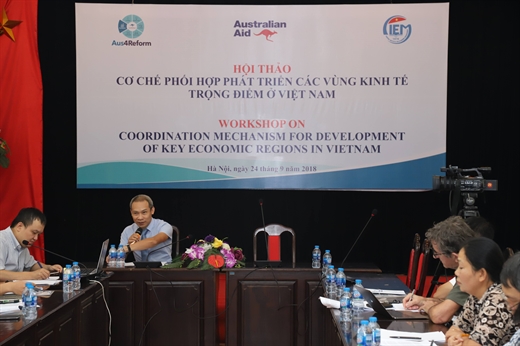Australia supports Economic Reform in Vietnam (Aus4Reform)
- en
- News and Media
- Aus4Reform News
- Most of Vietnam key economic regions do not meet socio-economic targets
25/9/2018
Most of Vietnam key economic regions do not meet socio-economic targets
In the afternoon of September 24th, under the framework of the Australian Support for Vietnam's Economic Reform (Aus4Reform Program), the Central Institute for Economic Management (CIEM) organized a workshop on "The Mechanism of Coordination for the development of key economic regions in Vietnam".
Most of Vietnam key economic regions do not meet socio-economic targets
In the afternoon of September 24th, under the framework of the Australian Support for Vietnam's Economic Reform (Aus4Reform Program), the Central Institute for Economic Management (CIEM) organized a workshop on "The Mechanism of Coordination for the development of key economic regions in Vietnam".
At present, there is no tight link among Vietnam's key economic regions (KERs), and economic activities are fragmented and weak. Therefore, it is necessary to create a new mechanism to boost regional economic development. In this context, the Aus4Reform Program has assisted CIEM to conduct researches on the coordination mechanism for the development of key economic zones. A workshop is held to share experiences, identify issues, and propose solutions, policies to promote cooperation among localities in KERs in socio-economic development.
 |
Limited connectivity among economic zones
Mr. Tran Trung Hieu, Deputy Director of Economic Institutions Committee (CIEM) said that the current division into 63 provinces and cities across the country makes coordination mechanism between regions actually difficult, fragmented and hard to be controlled. Accordingly, it is essential to build a mechanism of regional connectivity in the new context.
Assessing the effectiveness of linkages in the economic region in Vietnam is still very weak. The research group points out that the four KERs are the Northern KER, the Central KER, the Southern key economic and the Mekong River delta KER. These four major economic regions comprise 24 provinces and cities with an area of 90,000 km2, accounting for 27% of the national population and over 50% of the regional population, but the economic growth is unbalanced and disproportionate.
Based on data 2015, the total contribution to exports of all four regions is only 80.6%, of which the Northern and Southern key economic region has accounted for 78.1%, the remaining two regions only represented at 2.5 %.
The research report also indicates that the KERs has shown extremely poor socio-economic development and most of the indicators have not met the target. For example, the GDP, economic structure, urbanization, poverty rate, most of them has not reached the objective, only the Northern KER meets the destination in the GDP and urbanization.
According to Mr. Hieu, the reason is that the level of local economic development is poor, the policy mechanism for the key economic region is not complete and the linkage mechanism is unavailable, the perception of the interests of the entities related is not replete.
Some suggestions for coordination mechanisms for development of Vietnam KERs
The research team has proposed solutions to make and coordinate the development of key economic regions more specifically as follows:
Constructing interregional economic zones: Implementation of regulations in order to ensure revenue sources to carry out the regional linkage content corresponding to the regional spending tasks; Building the regional power organization; Carrying out specific zoning process, ensuring integration when overlapping.
Specific proposals - linking content: Developing and implementing strategic regional plans; Issuing Decrees and guidelines for the construction and implementation of the Planning Law; Promulgating implementing criteria and guides to select public investment projects servicing the linkage contents of the major economic zones; Issuing a breakthrough policy, a law or a decree on the development of KERs to institutionalize and resolve congestions in regional mechanism.

